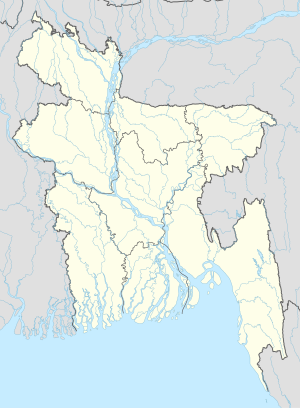Parbatipur Junction railway station
Parbatipur Junction Railway Station | |||||
|---|---|---|---|---|---|
| Bangladesh Railway Junction Station | |||||
 Parbatipur Railway Junction Station | |||||
| General information | |||||
| Location | Parbatipur, Dist. Dinajpur | ||||
| Coordinates | 25°39′13″N 88°54′56″E / 25.6536°N 88.9155°E | ||||
| Owned by | Bangladesh Railway | ||||
| Line(s) | Chilahati-Parbatipur-Santahar-Darshana Line, Burimari-Lalmonirhat-Parbatipur Line, Parbatipur-Panchagarh Line | ||||
| History | |||||
| Opened | 1878 | ||||
| |||||
Parbatipur Junction Railway Station (Template:Lang-bn) is a railway junction in Dinajpur district of Rangpur Division in Bangladesh.
History
During the British period all railway connections to Assam and North Bengal were through the eastern part of Bengal. From 1878, the railway route from Kolkata, then called Calcutta, to Siliguri was in two laps. The first lap was a 185 km journey along the Eastern Bengal State Railway from Calcutta Station (later renamed Sealdah) to Damookdeah Ghat on the southern bank of the Padma River, then across the river in a ferry and the second lap of the journey, which was a 336 km metre gauge line of the North Bengal Railway that linked Saraghat on the northern bank of the Padma to Siliguri.[1]
The 1.8 km long Hardinge Bridge across the Padma came up in 1912.[2] In 1926 the metre-gauge section north of the bridge was converted to broad gauge, and so the entire Calcutta - Siliguri route became broad-gauge.[1] Parbatipur came up as a station on the Calcutta-Siliguri route.
Once Parbatipur came up as a railway station on the Chilahati-Parbatipur-Santahar-Darshana Line in 1876, it became a centre of further railway development. There were two developments, one eastward and the other westward. North Bengal State Railway opened a metre gauge line to Kaunia in 1879. Two narrow gauge lines were laid by Eastern Bengal Railway from Kaunia to Dharla River. The Kaunia Dharla railway lines were converted to metre gauge in 1901. The Kaunia-Dharla line was extended to Amingaon in 1908. The Assam Behar State Railway started building westward in 1884 and by 1889, Parbatipur was connected with Katihar in Bihar.[3]
With the partition of India, railway links outside Bangladesh were lost but Parbatipur continued to be an important railway junction.
External links
References
- ^ a b "India: the complex history of the junctions at Siliguri and New Jalpaiguri". IRFCA. Retrieved 2012-02-07.
- ^ Chowdhury, Sifatul Quader (2012). "Hardinge Bridge". In Islam, Sirajul; Jamal, Ahmed A. (eds.). Banglapedia: National Encyclopedia of Bangladesh (Second ed.). Asiatic Society of Bangladesh.
- ^ R.P. Saxena. "Indian Railway History timeline". Archived from the original on 2012-02-29. Retrieved 2012-02-01.

